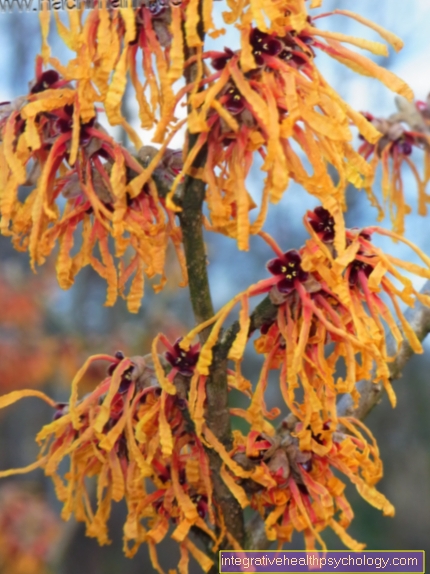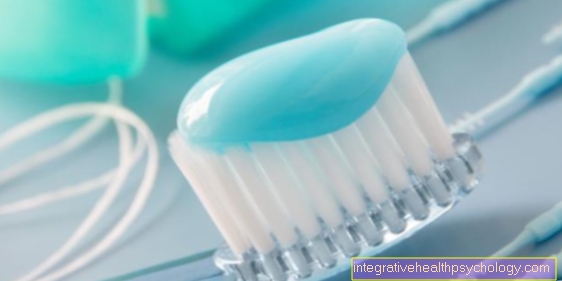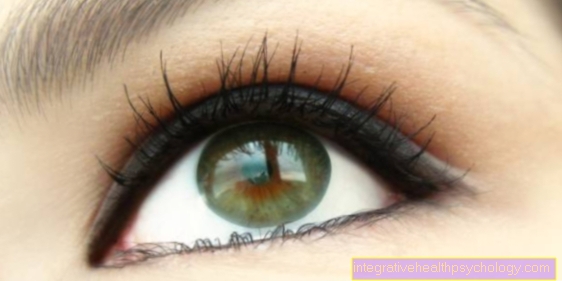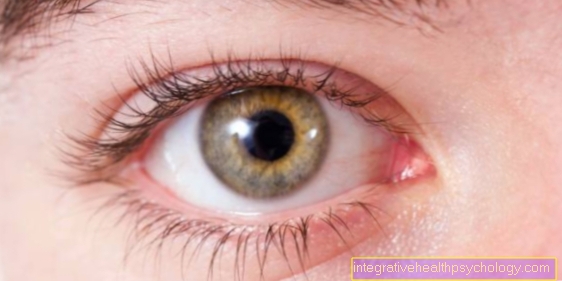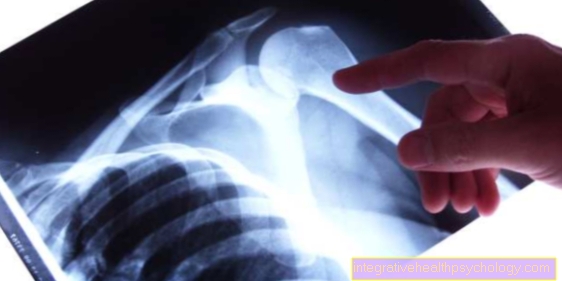Rash on the hands
definition
A rash on the hands is initially understood to mean visible skin changes on the hands. By definition, a rash is a so-called "Rash". Skin changes of the same kind are characteristic. the same looking redness next to each other. In order to better define the rash, various properties can be assessed such as location (palm, back of the hand, fingers ..), distribution (symmetrical, striped, circular ..) and character (scaly, blistered, reddened ..).

causes
The most common causes of a rash on the hands are listed below. The individual illnesses are then explained in more detail.
- Allergic contact eczema
- Toxic contact eczema
- Dry skin
- Hand, foot and mouth disease or scarlet fever
- stress
- Neurodermatitis
- Mental causes
- Infectious diseases such as syphilis and shingles
Allergic contact eczema
Sometimes there can be a rash behind on the hands allergy hide. In principle, numerous substances can be the cause here. Often, however, these are work-related substances or cosmetics (e.g. fragrances in hand creams).
Please also read our topic on this Rash from allergy
Toxic contact eczema
The so-called "toxic contact eczema“Is based on direct contact of the hands with irritating substances. Our hands often come into contact with harmful substances in everyday activities or at work. These include e.g. Detergents, citric acid, alkalis or hairdressing chemicals. That is why one speaks occasionally of "housewife eczema" or "hairdresser eczema"
Hand, foot and mouth disease
Typically, children get the virus-borne rash. Occasionally, however, adults also suffer from the condition.
The highly contagious pathogens spread via droplets and cause skin rashes in the hands, feet and mouth. Hand, foot and mouth disease is usually associated with painful inflammation of the oral mucosa. Hand, foot and mouth disease is usually caused by so-called enteroviruses of group A, which also include the Coxsackie virus.
Even with scarlet fever, an exanthem often occurs in childhood. As a rule, not only the hands are affected, but also the head and neck area. In addition, a coating on the tongue is typical, which leads to the so-called "strawberry tongue". The rash is usually without itching.
Please also read our topic on this Hand, foot and mouth disease such as Scarlet fever
Rash on hands due to dry skin
Healthy skin has a natural barrier function. This prevents potentially harmful substances from entering. At the same time, our skin maintains an important moisture balance. With dry skin, the barrier function is disturbed.
As a result, we lose moisture and natural skin oils.
In particular at claimed Parts of the body such as the hands are prone to dry skin by many people. A cracked, scaly or inflamed rash can be the unpleasant consequence.
Various factors also promote the development of dry skin. In particular too frequent hand washing using soap can permanently damage the barrier.
But also cold temperatures and dry heating air can cause dry skin and rashes on the hands of sensitive people, especially in winter.
To prevent a rash, we recommend the use of rich, low-scented and moisturizing hand creams.
Please also read our topic on this Dry skin on the hands
Rash due to stress
It is not for nothing that the popular wisdom ‘The skin is the mirror of the soul’ is on many lips. It is therefore not surprising that many people suffer from rash on their hands when they are stressed.
Pimples, redness or spots often appear on the face, neck or décolleté. Occasionally, rash from stress can also be observed on the hands.
In addition, many people tend to unconsciously “manipulate” their own skin when they are under psychological stress.
Nervous scratching or tingling, especially the cuticle, is not uncommon.
Excessive nail biting can also cause minor injuries to the fingers and create entry points for pathogens.
Read more on the topic Rash on finger
Constant stress also damages ours immune system. Responsible immune cells are shut down in their activity and our body is more susceptible to diseases, including those that affect the skin.
It is known that e.g. Neurodermatitis can worsen under psychological stress. Those affected can then suffer from a scaly and dry rash on their hands.
Stress-sensitive people can try to reduce their stress e.g. to reduce through autogenic training, yoga or relaxation exercises. Caring hand creams can prevent the hands from drying out.
Please also read our topic on this Stress rash
Neurodermatitis
Neurodermatitis is one of the most common inflammatory skin diseases. Typical are dry skin, pronounced itching and rash in the elbow and knee bends, body folds and on the back of the hand.
Especially children and adolescents in puberty can have dry spots, redness and flaking on their hands. Often a fine flaking of the fingertips can be added. In addition to the rash, those affected tend to have more lines on the palm of the hand.
The main problem of atopic dermatitis is the sometimes severe itching. In the acute "flare" of neurodermatitis, those affected can apply cortisone-containing ointments to their hands. In the long term, avoidance of allergy-causing substances and balanced, coordinated skin care are in the foreground.
Read more about this under:
- Neurodermatitis
- Neurodermatitis on the finger and fingernails
Mental causes
A mental rash on the hands is not uncommon. Often the treating dermatologists are at the end of their game and cannot find a physically tangible cause. Then one speaks of "idiopathic" Skin rash.
It occurs in psychologically stressful situations, such as Separation or loss of loved ones, exams or work stress.
Nevertheless, clarifying examinations should be carried out beforehand. This is the only way to rule out other causes (e.g. an allergy).
A kind of “symptoms diary” can be helpful. In this way, those affected can note when the rash occurs on their hands and whether there is a connection with psychological stress.
Skin rash with other infectious diseases
In addition to hand, mouth and foot disease and scarlet fever, there are other infectious diseases that lead to a rash but do not necessarily occur in childhood. On the one hand, syphilis should be mentioned in the secondary stage of which papules appear on the palms of the hands and feet. These are usually not associated with itching, but exanthemas are often found in the mouth and nose area and on the hairline. Fever is one of the accompanying symptoms of syphilis.
In addition, there is a skin rash with shingles, which in a few cases can also appear on the hands. The rash is usually unilateral and appears in a single spot with many vesicles.
Read more about these topics: Symptoms of syphilis such as Course of shingles
Symptoms
The main symptom of the rash is the visible change in the skin on the hands. Depending on the cause, they differ optically.
The range of possible manifestations is large and ranges from blisters and swellings to redness, scales, spots, etc.
Accompanying e.g. Itching, pain, or burning occurs.
Infectious diseases such as hand, foot and mouth disease or Shingles (Herpes zoster), appear next to the rash on the hands so-called "Systemic" symptoms of the organism. These can include fever, inflammation of the oral mucosa or fatigue.
Blistered rash
In the first moment the appearance of Vesicles if the rash on the hands give those affected a real shock.
Most of the time, however, the rash is harmless and looks worse than it actually is.
First and foremost, vesicles appear in the strongly pronounced Contact eczema hands on.
Usually this skin change is one Redness of the affected area ahead. Subsequently, small vesicles, about the size of a pinhead, form. They are filled with clear fluid and sometimes itch and burn considerably.
There is an almost involuntary "scratch reflex" - the blisters burst and ooze. If the trigger (e.g. cleaning agent) is subsequently avoided, healing takes place with the formation of Crusts.
In the context of toxic contact eczema or neurodermatitis, a so-called "dyshidroic“Eczema occur. Very itchy and grouped blisters on the palm of the hand are typical.
You can find more information on this topic here: Blistered rash
Itchy rash
Itchy rash on the hands can be very annoying for those affected. Often they can hardly pull themselves together and scratch the annoying rash almost automatically.
Most skin symptoms on the hands are associated with itching.
Unfortunately, repeated scratching can be microscopic small wounds arise. Pathogens get into the skin and can there Infections trigger.
In order to relieve the itching, the primary cause of the rash needs to be found out.
In the case of contact eczema, the triggering substances should be strictly avoided. They may be suitable for bridging cortisone-containing ointments.
In severe cases it is necessary to take appropriate Cortisone tablets should be considered.
Sometimes cooling compresses soothe the excruciating itchiness.
Rash without itching
As a rule, skin rashes on the hands without accompanying itching are rarely observed. Often the lack of itchiness speaks for a temporary, short term Skin irritation.
An exception is the scaly skin rash on the palms and feet after overcoming it Scarlet fever infection.
Especially children between the ages of 4 and 10 fall ill with the infection transmitted by bacteria (streptococci). A sore throat with a high fever, "strawberry tongue" and a fine, red skin rash all over the body is characteristic. In the 2nd-4th During the week of the illness, the characteristic and scaly rash on the hands can be observed.
Please also read our topics Rash without itching, scarlet fever rash
If you have any complaints, please also do our self-test skin rash by:
therapy
First of all, you should try to fathom the origin of the rash on the hands. For now, you should ask yourself:
- Have your hands come into contact with unusual substances before?
- Have you seen the rash before?
- Do you suffer from eczema?
The answers can often provide initial clues.
In any case, it is advisable to strictly avoid potentially triggering factors. These include above all Soaps, cleaning products, oils, solvents and chemicals. In principle, however, allergic reactions to almost any substance are possible. Often it is enough to avoid the substances described to make the rash go away.
Adequate skin care is also essential. Make sure you use enough moisturizing hand creams especially for sensitive hands, preferably without fragrances.
And even if it is difficult, try to scratch as little or not at all: this will further irritate the skin and make the rash worse.
If the rash on the hands increases despite the above measures or if further symptoms appear, you should consult a doctor.
Under certain circumstances, a prescription drug must be used or further investigation must be carried out. In the dermatologist's practice, for example, you may be offered help on how to protect your hands from harmful substances in everyday (professional) life.
Read more on the topic Treat rash with ointments and creams and Home remedies for a rash
Rash on hands involving feet
If a rash can be seen on both feet and hands, it is probably not the typical contact eczema. The “double” rash is much more likely to occur in one Infectious disease, such as. Scarlet fever or the hand, foot and mouth disease.
If the skin on your hands and feet peels by itself and can be peeled off painlessly, a subsided Scarlet fever infection behind it. As a rule, nothing has to be done therapeutically.
Occasionally the so-called "dyshidrotic eczema“Hide behind the rash. Small and very itchy blisters on the hands and feet in particular speak for this harmless disease.
If there is an additional rash on the foot, it is also recommended to do this at home Refrain from wearing socks and shoes. Because a film of sweat quickly develops under the socks. This makes it easier for harmful pathogens to penetrate the damaged skin of the feet.
Rash on the hands in the child
A rash is more common in children. Many teething troubles show that the skin is involved.
As mentioned above, the most typical disease is hand, foot and mouth disease. This leads to redness and small blisters in the area of the soles of the feet and the palm of the hand. Inflammation of the oral mucosa can be accompanying Canker sores occur.
Hand, foot and mouth disease is transmitted by Group A Coxsackie viruses and is highly contagious. However, it is almost always harmless and does not require any therapy.
Of course, children under one can also Contact eczema of the hands suffer. However, the rash on the hands is often of an allergic nature. Particularly in children with known allergic pre-existing diseases (hay fever? Asthma? Neurodermatitis?) Caution is required.
Rash on hands during pregnancy
During pregnancy are skin changes No rarity. It goes without saying that expectant mothers are particularly vigilant and watch changes in their bodies and skin with concern. Fortunately, in the vast majority of cases, skin rashes on the hands hide harmless causes!
So can also be used in pregnancy Contact eczema the hands occur. Pregnant women should avoid the triggers whenever possible.
It is not uncommon for expectant mothers to take advantage of this extra rich skin care. However, oils, creams or ointments can also cause allergies, including on the hands, trigger. Sensitive women can be prone to skin rashes, especially when using fragrance-based care products.
Since Coxsackie viruses are very common, pregnant women can also suffer from hand, mouth and foot disease. Fortunately, at this point in time, there is no evidence of possible harm to the unborn child.
Also the hormonal changes during pregnancy can play a role in developing skin rashes.
Please also read our topic on this Rash in pregnancy
diagnosis
For a successful therapy, the most accurate diagnosis possible should first be made. For this purpose, those affected should have a Dermatologist seek out. Specific questions can narrow down possible causes:
When does the rash appear? Is there a connection with a specific activity? Are the hands itchy? ...
Then the hands are examined. Sometimes the doctor recognizes the diagnosis at first glance.
A typical finding is e.g. the "dyshidrotic hand eczema“With its small, bulging and itchy blisters on the palm of the hand. Sometimes additional rash samples may be required. Under the microscope these can be tiny Skin samples are examined and contribute to a successful diagnosis.

.jpg)
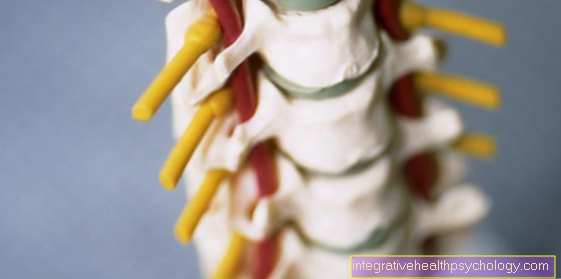


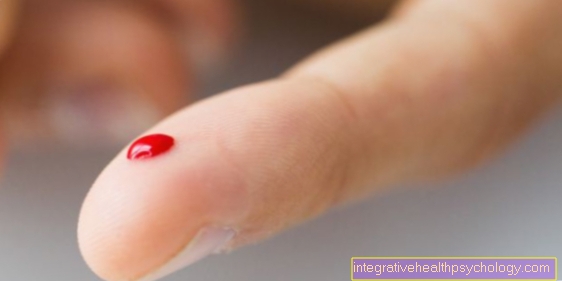







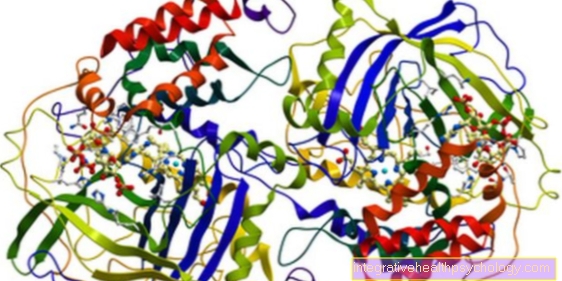
.jpg)



